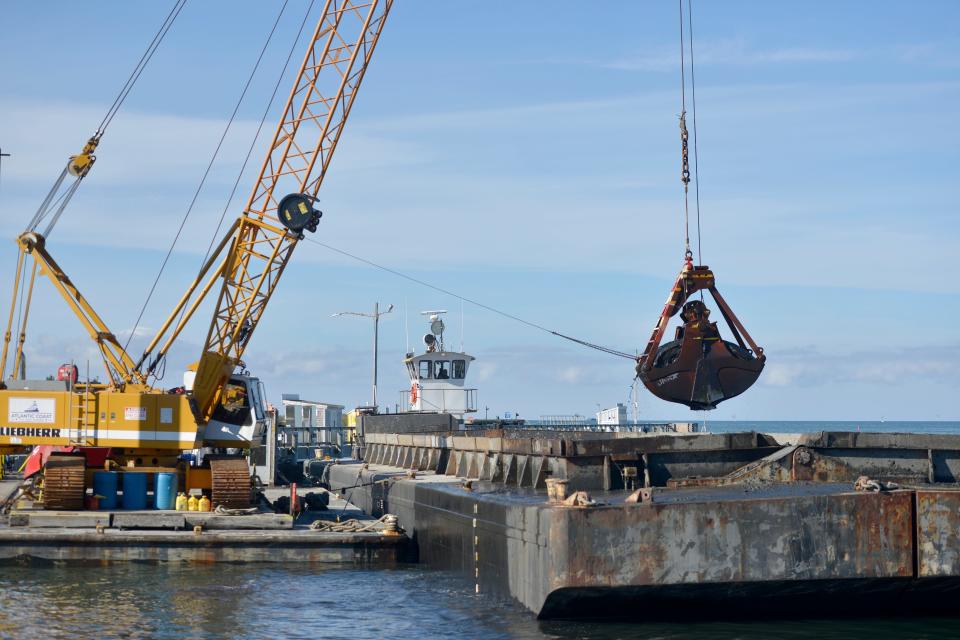Wellfleet Selectboard agrees to $3.8 million dredgework. Will swallow $4.5 million penalty
WELLFLEET — Dredging, the task all Cape towns have to deal with regularly, is going to cost Wellfleet taxpayers a hefty amount in 2024.
The 110,000 cubic yard dredge is estimated to cost $3.8 million with an additional $4.5 million penalty fee.
The Selectboard voted 3-2 Tuesday to go ahead with a plan to pay $4.5 million to the US Army Corps of Engineers for a 10-year permit to dredge the Area 2 mooring field. They decided not to pursue a mitigation plan that would offset that fee.
The $4.5 million is a penalty the town must pay for not doing maintenance dredging in that area of the harbor. Because Area 2 was last dredged in 1957, the Corps considers it new dredging rather than maintenance dredging. New dredging must take into consideration any damage done to the biodiversity in the harbor. The $4.5 million figure was based on credits determined by the Corps, and a payment formula recommended by the state’s Department of Fish and Game.

On Aug. 22, the selectboard rejected a mitigation plan proposed by the Dredging Task Force that would have avoided the penalty fee in exchange for restoring a portion of Blackfish Creek. Opponents of the plan cited unknowns such as feasibility, timelines, monitoring and personnel costs, and lack of assurances from property owners surrounding Blackfish Creek.
Residents will need to vote on a spring town meeting warrant article and at a town election to authorize borrowing the money.
Chairwoman Barbara Carboni and Michael Devasto voted against the motion. Carboni said she would have preferred the town work on details of a mitigation plan before asking voters to pay $4.5 million. The plan had been criticized by those who claimed benchmarks (improved water quality and increased oyster populations among other things) might never be reached and the town could be paying for the plan in perpetuity.
Devasto wasn’t convinced by opponents to restoration work that it would cost the town in perpetuity. He would have preferred to explore options before asking taxpayers for more money.
John Wolf and Timothy Sayre voted for paying the fee and getting the dredging done. Wolf said the vote was between “the devil we know and the devil we don’t know.” Sayre said he doesn't want the Corps to have an ongoing say in the town’s affairs. He was afraid a mitigation plan would have done that.
There was a long pause before Ryan Curley broke the 2-2 tie. He didn’t think the town could come up with another mitigation plan that the Corps and town residents would approve in the time allowed.
Deadlines for grant applications, grant expenditures, bids and contract awards, and dredging windows all come into play. A $2.5 million state grant with a 1:1 town match must be awarded to a contractor before June 30, 2024, or be returned to the state. There is $2.9 million in the town’s dredge account that will be used to match it. This money would pay for the $3.8 million dredge cost.
Town Manager Rich Waldo expects the town to pay $1.9 million and the state to pay $1.9 million to cover the cost of the $3.8 million dredge.
The $4.5 million penalty fee is an additional cost.
Joe Aberdale presented three different scenarios available to the town: 1. pay the $4.5 million fee for a 10-year dredge permit; 2. split the $4.5 million over two years for a 10-year dredge permit; 3. develop a mitigation plan. The state is expected to raise fees 30% which would increase the cost of the second scenario.
Aberdale is the only remaining member of the Dredging Task Force. Co-chair Chris Allgeier, Curt Felix and Charles “Skip” Annett resigned after the selectboard tossed out the mitigation plan.
Fourteen of the Cape's 15 towns use the Barnstable County Dredge services to keep their harbors and waterways economically and environmentally vibrant. More than 150,000 cubic yards were dredged in the 2020-2021 season according to Barnstable County.
It's estimated that tourism, commercial and recreational fishing activities contribute millions annually to the Wellfleet economy.
"Wellfleet Harbor is an economic engine for the town," Waldo said.
Denise Coffey writes about business and tourism. Contact her at dcoffey@capecodonline.com.
Thanks to our subscribers, who help make this coverage possible. If you are not a subscriber, please consider supporting quality local journalism with a Cape Cod Times subscription. Here are our subscription plans.
This article originally appeared on Cape Cod Times: Wellfleet swallows $4.5 million penalty to dredge Wellfleet Harbor

